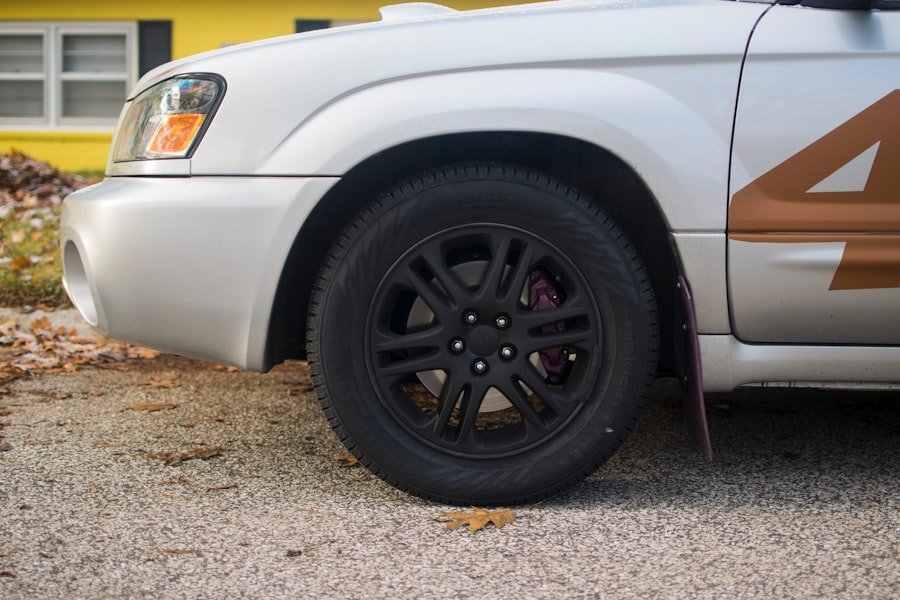Tire rotation is a critical aspect of vehicle maintenance that often goes overlooked by many drivers. The primary purpose of tire rotation is to ensure even wear across all tires, which can significantly extend their lifespan and improve overall vehicle performance. Tires wear differently depending on their position on the vehicle; for instance, front tires typically experience more wear due to steering and weight distribution, especially in front-wheel-drive vehicles.
By regularly rotating the tires, you can help mitigate this uneven wear, leading to a more balanced ride and enhanced safety. Moreover, proper tire rotation can contribute to better fuel efficiency. When tires are worn unevenly, they can create additional drag and resistance, forcing the engine to work harder to maintain speed.
This inefficiency can lead to increased fuel consumption, which not only impacts your wallet but also contributes to higher emissions. Regularly rotating your tires can help maintain optimal contact with the road, ensuring that your vehicle operates smoothly and efficiently. In essence, tire rotation is not just about prolonging the life of your tires; it’s also about enhancing your vehicle’s performance and safety.
Key Takeaways
- Tire rotation is important for maintaining even tread wear and extending the life of your tires.
- Signs that your tires need rotation include uneven tread wear, vibrations, and increased road noise.
- Tires should be rotated every 6,000 to 8,000 miles, or as recommended by your vehicle’s manufacturer.
- Tools needed for tire rotation include a jack, jack stands, lug wrench, and a torque wrench.
- Proper tire maintenance also includes checking tire pressure, alignment, and tread depth regularly.
Signs that Your Tires Need Rotation
Recognizing the signs that your tires need rotation is essential for maintaining optimal vehicle performance. One of the most common indicators is uneven tread wear. If you notice that one side of your tire is significantly more worn than the other, it’s a clear sign that a rotation is necessary.
This uneven wear can often be observed visually; for example, if the outer edges of your front tires are bald while the center tread remains intact, it indicates that the tires are not making even contact with the road surface. Another sign that your tires may need rotation is a change in handling or ride quality. If you begin to feel vibrations or notice that your vehicle pulls to one side while driving, it could be due to uneven tire wear.
These symptoms can compromise your control over the vehicle and increase the risk of accidents. Additionally, if you hear unusual noises coming from your tires, such as thumping or humming sounds, it may indicate that they are not wearing evenly and require immediate attention. Regularly checking for these signs can help you stay ahead of potential issues and ensure a safer driving experience.
How Often Should You Rotate Your Tires?

The frequency of tire rotation can depend on several factors, including the type of vehicle you drive, your driving habits, and the type of tires you have installed. A general rule of thumb is to rotate your tires every 5,000 to 7,500 miles. However, it’s essential to consult your vehicle’s owner manual for specific recommendations tailored to your make and model.
Some manufacturers may suggest more frequent rotations, especially for vehicles with performance tires or those that are driven under severe conditions. Driving conditions play a significant role in determining how often you should rotate your tires. For instance, if you frequently drive on rough or unpaved roads, or if you often carry heavy loads, your tires may wear more quickly and require more frequent rotations.
Similarly, if you engage in aggressive driving habits such as rapid acceleration or hard cornering, this can also lead to uneven tire wear. Keeping track of your mileage and being mindful of your driving conditions will help you establish a rotation schedule that best suits your needs.
Tools Needed for Tire Rotation
| Tools Needed for Tire Rotation |
|---|
| Jack |
| Lug Wrench |
| Torque Wrench |
| Wheel Chocks |
| Jack Stands |
Before embarking on a tire rotation, it’s crucial to gather the necessary tools to ensure the process goes smoothly and safely. The most essential tool is a lug wrench, which is used to loosen and tighten the lug nuts that secure the tires to the wheel hub. A cross-shaped lug wrench can provide better leverage compared to a standard one, making it easier to loosen stubborn lug nuts.
In addition to a lug wrench, a hydraulic jack or a car lift is necessary for raising the vehicle off the ground. A jack stands are also recommended for added safety once the car is lifted; they provide stability and prevent accidental lowering while you work on the tires. A tire pressure gauge is another useful tool to have on hand; after rotating your tires, it’s important to check and adjust tire pressure as needed to ensure optimal performance.
Having these tools ready will streamline the tire rotation process and enhance safety.
Step 1: Loosening the Lug Nuts
The first step in rotating your tires involves loosening the lug nuts on each wheel before lifting the vehicle. It’s advisable to perform this step while the car is still on the ground; this prevents the wheel from spinning while you apply force with the lug wrench. Begin by using the lug wrench to turn each lug nut counterclockwise until they are loose but not completely removed.
It’s important to follow a star pattern when loosening lug nuts; this ensures even pressure distribution and reduces the risk of warping the brake rotor.
Allowing the oil to sit for a few minutes before attempting to loosen them again can make a significant difference.
Once all lug nuts are loosened, double-check that they are not fully removed yet; this will allow for easier removal once the car is lifted.
Step 2: Lifting the Car

Once the lug nuts are loosened, it’s time to lift the car off the ground using a hydraulic jack or car lift. Position the jack under the vehicle at designated lift points as specified in your owner’s manual; these points are designed to safely support the weight of the car without causing damage. If using a hydraulic jack, pump the handle until the vehicle is raised high enough for you to comfortably remove the tires.
After lifting the car, it’s crucial to place jack stands under the vehicle for added safety. Jack stands provide stability and prevent accidental lowering while you work on changing out the tires. Ensure that they are positioned securely under solid parts of the frame or suspension components.
Once everything is stable and secure, you can proceed with removing the tires.
Step 3: Removing the Tires
With the car securely lifted and supported by jack stands, you can now proceed to remove each tire from its wheel hub. Begin by fully removing each lug nut that was previously loosened; keep them in a safe place as you will need them later when reinstalling the tires. Carefully pull each tire straight off from its mounting position; if a tire feels stuck due to rust or dirt buildup, gently rock it back and forth while pulling outward.
As you remove each tire, take a moment to inspect its condition closely. Look for any signs of damage such as cuts, bulges, or punctures in the sidewall or tread area. Additionally, check for uneven wear patterns that may indicate alignment issues or other mechanical problems with your vehicle.
Documenting any concerns will help you address them promptly and maintain optimal tire health.
Step 4: Rotating the Tires
Now that all tires have been removed from their respective positions, it’s time to rotate them according to your vehicle’s recommended pattern. The most common rotation patterns include front-to-back and side-to-side rotations; however, some vehicles may require specific patterns based on their drivetrain configuration (e.g., front-wheel drive vs. all-wheel drive). Consult your owner’s manual for guidance on which pattern is appropriate for your vehicle. When rotating tires, it’s essential to pay attention to their directional nature if applicable; some tires are designed with specific tread patterns that dictate their direction of rotation. Ensure that these tires are mounted correctly according to their intended direction when reinstalling them on the vehicle. After placing each tire in its new position, take a moment to inspect them again for any visible issues before moving on to reinstalling them.
Step 5: Reinstalling the Tires
With all tires rotated into their new positions, it’s time to reinstall them onto the wheel hubs. Begin by aligning each tire with its corresponding hub and carefully pushing it onto the mounting surface until it sits flush against the brake rotor or drum. Once in place, hand-tighten each lug nut onto its respective stud; this will help secure the tire temporarily while you prepare for tightening.
It’s important to follow a star pattern when tightening lug nuts as well; this ensures even pressure distribution across the wheel and helps prevent warping of brake components. Using your lug wrench, tighten each nut incrementally rather than fully tightening one at a time; this method allows for better alignment and reduces stress on individual components.
Step 6: Lowering the Car and Tightening the Lug Nuts
After all tires have been reinstalled and hand-tightened, it’s time to lower the car back down to ground level. Carefully remove jack stands from under the vehicle before using your hydraulic jack or lift to lower it slowly back onto its wheels. Once fully lowered, take a moment to ensure everything is stable before proceeding with final tightening of lug nuts.
Using your lug wrench again, go through each lug nut one last time and tighten them fully following the same star pattern used earlier. This final tightening ensures that all nuts are secure and reduces any risk of loosening while driving. It’s advisable to double-check torque specifications provided in your owner’s manual for optimal safety.
Final Tips for Proper Tire Maintenance
Proper tire maintenance extends beyond just regular rotations; it encompasses various practices aimed at prolonging tire life and ensuring safety on the road. One crucial aspect is maintaining proper tire pressure; under-inflated or over-inflated tires can lead to uneven wear and decreased fuel efficiency. Regularly checking tire pressure—at least once a month—is essential for optimal performance.
Additionally, consider scheduling regular alignments and balancing services as part of your maintenance routine. Misalignment can cause premature tire wear and affect handling characteristics while driving. Balancing ensures that weight is evenly distributed across all four tires, reducing vibrations and enhancing ride comfort.
By incorporating these practices into your routine maintenance schedule alongside regular rotations, you can significantly enhance both safety and longevity for your vehicle’s tires.
If you’re looking to properly rotate your car tires, you may also be interested in learning how to find the perfect drawer organizer for your home. Check out this article on finding the perfect drawer organizer for your home to keep your living space neat and organized.
FAQs
What is tire rotation?
Tire rotation is the process of moving the tires from one position on the car to another in order to ensure even tire wear and extend the life of the tires.
Why is tire rotation important?
Tire rotation is important because it helps to ensure that the tires wear evenly, which can improve the overall performance and safety of the vehicle. It can also extend the life of the tires, saving money in the long run.
How often should I rotate my car tires?
It is generally recommended to rotate your car tires every 6,000 to 8,000 miles, or as specified in your vehicle’s owner’s manual. However, it’s a good idea to check your tires regularly for signs of uneven wear and rotate them as needed.
How do I rotate my car tires properly?
To rotate your car tires properly, you should follow the specific rotation pattern recommended by your vehicle’s manufacturer. This may involve moving the front tires to the rear and the rear tires to the front, or crossing the tires from one side of the vehicle to the other.
Can I rotate my car tires myself?
Yes, you can rotate your car tires yourself if you have the necessary tools and knowledge. However, if you are not comfortable doing it yourself, it’s best to have a professional mechanic perform the tire rotation for you.
What are the benefits of rotating car tires properly?
Rotating car tires properly can help to ensure even tire wear, improve vehicle performance, extend the life of the tires, and save money on replacement tires in the long run.

